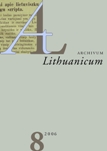Kazimiero Lelio ir Ipolito Liutostanskio lietuviškos kirilikos modeliai, 1887–1891
Kazimieras Lelys' and Ipolitas Liutostanskis' models of Lithuanian cyrilic script in 1887-1891
Author(s): Giedrius Subačius Subject(s): Theoretical Linguistics, Lithuanian Literature, Baltic Languages, 19th Century
Published by: Lietuvių Kalbos Institutas
Keywords: Kazumieras Lelys'; Ipolitas Liutostanskis'; Lithuanian cyrilic script; 19th century; Lithuanian cyrlic; orthography;
Summary/Abstract: Both Kazimieras Lelys and Ipolitas Liutostanskis were the authors of individual models of Lithuanian Cyrillic script. They were original in the sense that Lelys and Liutostanskis never followed other known patterns. Originality is observed also in the novelty of the topics selected—their books were respectively advice for tailors and translations of fiction. Lelys and Liutostanskis were the first to prepare and to publish books of this sort in Lithuanian Cyrillic. All four books were published in the period 1887–1891; Kazimieras Lelys’ Лѣтувосъ кряучѣмъ драпану сукирпима моксласъ (1887; The Art of Cutting Cloth for Lithuanian Tailors); Ipolitas Liutostanskis’ translations of Leo Tolstoy’s short stories: Ишлайденсъ угни, не бе ужгясинси (1888; Put Out the Fire Or It Will Spread), Кауказа невальникасъ (1891; A Prisoner in the Caucasus) and Куръ мяйле, тенъ и Девасъ (1891; Where Love Is, God Is). Thus, we can speak about the period when the new untypical models emerged (the unique model of Eduardas Volteris could also be included here—in 1887 he published Девiшка лiтургijа Швэто Jно Aксобрнiо (The Divine Liturgy of St. John Chrysostom). Lelys was an Eastern Highlander from the Panevėžys district and he wrote his book in his native dialect. Liutostanskis was most probably a Southern Lowlander, but along with the forms of his native dialect he also used certain Highland Lithuanian features. On the other hand, Zacharijas Liackis (the reviewer [editor] of Liutostanskis’ translations) was from the Panevėžys district. Thus, some Highland Lithuanian dialectal features might occur in Liutostanskis’ translations due to the intervention of Liackis. Besides, Andrius Poidėnas, who was the meticulous proofreader of A Prisoner in the Caucasus, might have been responsible for certain orthographical decisions in the final pamphlet as well.
Journal: Archivum Lithuanicum
- Issue Year: 2006
- Issue No: 08
- Page Range: 279-316
- Page Count: 38
- Language: Lithuanian

